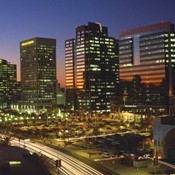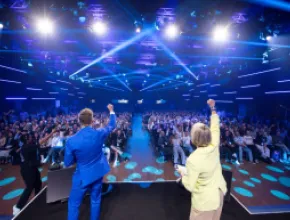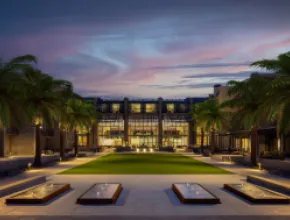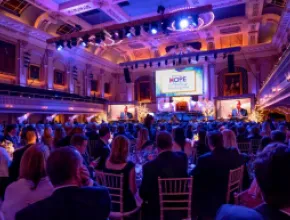Although statehood for both Arizona and New Mexico only dates back to 1912, both destinations boast long and colorful histories that encompass some of the earliest European settlement in the New World. This is a land where Spanish explorers, Mexican caballeros, hardscrabble pioneers, and Billy the Kid and other Wild West figures have all left their marks in ways that can still be experienced today.
For meetings, this legacy is packed with possibilities that range from cowboy cookouts to Mexican rodeos to elegant balls recalling the days of cattle barons and their ladies.
According to Kathleen Glenn, general manager of Scottsdale, Ariz.-based Southwest Conference Planners, events that draw on the region’s iconic heritage are surefire crowd-pleasers.
“The cowboy cookout is by far the most popular thing we do,” she says. “People get a sense of really being in the West.”
When it comes to an opening reception, Glenn says a Mexican theme is an upbeat way to kick-start a meeting.
“People are greeted with margaritas and there are colorful costumes and mariachi bands,” she says. “It’s a great introduction to the area.”
At the same time, the Southwestern legacy goes beyond the familiar Old West and Spanish themes in ways that visitors sometimes don’t expect.
“We’ve done Mountain Men Rendezvous theme parties with actors playing the roles of early Anglo explorers,” says Arlene Schiffer, president of Passport New Mexico, a DMC based in Santa Fe. “Or we can do a Civil War theme. Major battles were waged here during the Civil War because the Confederates were trying to bring gold out of California. Santa Fe was known as the Gettysburg of the West.”
New Mexico’s Spanish Roots
New Mexico served as a Spanish outpost in the New World from 1607 to 1821 and then a province of Mexico before becoming a U.S. territory in 1848. In both Santa Fe and the Old Town section of Albuquerque there are many reminders of the state’s Spanish and Mexican periods, including landmarks and museums that make evocative settings for events.
Santa Fe’s Palace of the Governors, which dates from 1609 and is the oldest public building in the nation, served as the seat of government for four sovereign nations: Spain, Mexico, the Confederacy, and the U.S. Since 1909 it has been a museum dedicated to the multicultural history of New Mexico, housing rare photographs, paintings, manuscripts, and artifacts such as a Spanish conquistador’s helmet.
The Palace of the Governors, which is built around a large courtyard accommodating up to 200 people, also frequently serves as a venue for special events with a Spanish or Mexican theme.
“We’ve turned the courtyard into a Mexican village with salsa dancers, paper flowers, food stations, and tables covered with serapes,” Schiffer says. “It also works well as a rustic Spanish village reminiscent of early Spanish settlements in New Mexico. You can include a flamenco performance and tapas served family-style at the tables.”
Schiffer adds that events with a Spanish or Mexican fiesta theme also work well in Milner Plaza, a central area in Santa Fe’s Museum Hill complex flanked by the Museum of Spanish Colonial Art, the Museum of Indian Arts & Culture, the Museum of International Folk Art, and the Wheelwright Museum of the American Indian.
“Santa Fe’s museums are great backdrops for events, but you can’t take food and beverage into all of the areas,” Schiffer says. “So it’s best to hold a big event in Milner Plaza and then people can visit the various museums from there.”
In Albuquerque, Old Town retains plenty of colonial charm with its adobe building surrounding a central plaza, which is anchored by the stately, late 18th century San Felipe de Neri church, one of the oldest in New Mexico. Old Town Plaza is the scene of traditions such as the San Felipe Fiestas, held every year in late May and early June, and a spectacular display of luminarias, which are paper bags with glowing votive candles inside, on Christmas Eve.
One of Old Town’s most versatile venues is the Albuquerque Museum, a leading showcase for the art, history and culture of the Southwest. The museum includes a large collection pertaining to Albuquerque history and artwork by New Mexico artists.
With large indoor spaces and outdoor sculpture gardens, the museum is a superb venue for gala events, according to Schiffer.
“The museum has a huge open lobby area where you can do things like a cattle baron’s ball with people in 19th century costumes,” she says.
In addition, the Albuquerque Museum owns the historic Casa San Ysidro, a circa-1870 house museum that is located just north of Albuquerque in Corrales. The house and grounds provide an illustration of life on a 19th century ranch, complete with a small family chapel and an enclosed corral.
Hispanic heritage and modern art and culture is the focus of Albuquerque’s National Hispanic Cultural Center, which opened in 2000 and has staged over 25 art exhibitions and 500 programs in the visual, performing and literary arts. The programs have featured local, national and international artists, scholars and entertainers.
For special events, the National Hispanic Cultural Center provides a wide variety of venues, including the Plaza Mayor, an outdoor function area that can accommodate up to 2,000 people for galas with live music and dance performances. Designed for sit-down banquets as well as receptions and lectures, the Salon Ortega is a spacious room with Spanish detailing that opens onto a central courtyard.
Other spaces include La Fonda del Bosque Restaurant, which offers a central patio and adjacent outdoor lawn, a 97-seat auditorium with audiovisual capabilities and a 291-seat theater fully equipped for film, lecture and music presentations.
Arizona’s Spanish Legacy
In Arizona, Tucson and its environs are especially rich in early Spanish colonial history. The first Europeans to visit the region are thought to have been shipwrecked 16th century Spanish explorers, the first of a stream of gold-seekers and missionaries.
The earliest European settlement still standing in Arizona is Tubac Presidio, now a state historic park 19 miles south of Tucson that was founded in 1751 as a military outpost. Portions of the original presidio, which were excavated in 1974, are showcased in an underground display area. Visitors can view portions of the original foundation, including the walls and plaza floor of the commandant’s quarters, as well as artifacts from various periods of Tubac’s history.
Making the Spanish frontier come alive at Tubac are costumed interpreters called Tubaquenos, who share stories with visitors to the presidio on Sunday afternoons from October through March. From Oct. 20-21, Tubac is the scene of Anza Days, a cultural event commemorating the passage of Juan Bautista de Anza and his soldiers, who trekked through the region on their way to establishing a military base in San Francisco.
Facilities for groups at Tubac include a picnic area surrounding a pavilion where folkloric music and dances can be performed, and Otero Community Hall.
A visit to Tubac can easily be combined with Mission San Xavier del Bac, a gleaming white church known as the “White Dove of the Desert,” built between 1783 and 1797 and considered to be the finest example of mission architecture in the U.S.
Tucson, founded as a Spanish presidio in 1775 and part of Mexico from 1821 to 1854, still has much of its early history in evidence, particularly in areas such as the historic Presidio and Barrio districts.
“Downtown Tucson has a lot of history and culture,” says Toby King, director of convention sales for the Metropolitan Tucson CVB.
In particular, King suggests that visitors check out Old Town Artisans, a complex that includes artists’ studios and La Cocina, a restaurant in an 1850s adobe where group lunches can be arranged.
“Before Arizona was a state, the stagecoaches would stop at what is now Old Town Artisans,” she says. “The men would head to a saloon and ladies to a rest area. You can still see areas where the original walls and wallpaper remain.”
Early Tucson is a focus of the Tucson Museum of Art and Historic Block, which includes a strong collection of folk art form the Spanish colonial and post-colonial periods. The museum’s Historic Block presents five houses built between 1850 and 1907, which represent different eras in the city’s history.
The museum can accommodate indoor events for up to 250 people, while a spacious landscaped outdoor courtyard holds up to 750 people for receptions.
Wild, Wild West
The Southwest was home to some of the most feared outlaws and respected lawmen who gave the Old West its wild reputation. Arizona towns like Bisbee, Tombstone, Jerome, Prescott, and Yuma are places where visitors can still get a sense of that rough-and-tumble era.
According to Glenn at Southwest Conference Planners, full-day or half-day excursions to Arizona’s historic Old West towns are popular with groups.
“On the way to Sedona, it’s great to arrange a visit to Jerome,” she says. “It’s an old mining town that is now an artists’ colony. The old high school now houses artists’ studios. The historic Hotel Jerome is said to be haunted and is a great place to arrange a lunch at the hotel’s restaurant, which is called the Asylum. You really get a feel of the Old West there.”
For groups based in Tucson, she recommends an excursion to nearby Bisbee, which like Jerome was once a mining town.
“Bisbee has very steep streets with lots of historic buildings,” she says. “It’s especially fun to arrange a mining tour where people put on yellow slickers and headlamps and go deep into the bowels of the mines.”
In southwest Arizona, the Yuma Territorial Prison State Historic Park in Yuma offers a glimpse of life in the Old West’s most notorious prison. The stone walls and iron-gated cells, where over 3,000 prisoners were incarcerated between 1876 and 1909, are the focal point of the park, which also includes a museum and spacious grounds with picnic facilities for up to 1,000 people. A full calendar of special events includes Old West reenactments on every Sunday from October through April.
While Billy the Kid is one outlaw who never did time in Yuma, his life and times are captured at the Billy the Kid Museum in the eastern New Mexico city of Fort Sumner. The museum, which displays items such as the outlaw’s rifle, chaps, spurs, and original “wanted” poster, also has exhibits on early pioneer life and is just a few steps away from the outlaw’s gravesite.
In southern New Mexico, the Hubbard Museum of the American West in Ruidoso Downs is another museum focusing on the Old West era. Along with changing exhibits, the museum features Western art, cowboy artifacts and a Pony Express rig.
At the Desert Caballeros Western Museum outside Phoenix in Wickenburg, artwork from leading Western artists such as Frederic Remington and George Phippen are on display, while the museum’s Hall of History depicts Old West artifacts in period settings. Museum function spaces, including an area with an historic scene of old Wickenburg, can accommodate groups of up to 250 people for a reception.
Pioneer life in Arizona is also vividly illustrated at the Sedona Heritage Museum in Sedona’s Jordan Historical Park. The main building, an early 20th century farmhouse, features exhibits on early Sedona settlers and also includes an exhibit devoted to the 100-plus movies, mostly classic Westerns, that used Sedona’s dramatic red rock landscape as a location.
The museum’s 3,300-square-foot Apple Packing Shed is available for catered lunches that can include a speaker and video on Sedona history.
Back at the Ranch
When it comes to staging events with a Western theme, the Southwest provides ready-made backdrops at every turn.
One of the most extensive settings is Rawhide Western Town & Steakhouse, a 25-year-old attraction that moved to a new location two years ago at Wild Horse Pass in the Gila River Indian Community south of Phoenix. Rawhide’s extensive activities and attractions include stunt shows, a desert train, stagecoach rides, gold panning, specialty shops, and mechanical bull-riding competitions.
A frequent setting for theme parties and other events for up to 10,000 people, Rawhide features venues such as a 50,000-square-foot events lawn, a 52,000-square-foot, climate-controlled pavilion, a rodeo arena, a Spanish Mission-style patio, private cookout sites, and indoor function rooms.
Historic ranches and estates found throughout the Southwest are other popular choices for events with a Western theme. Among them is Corona Ranch & Rodeo Grounds, located just outside Phoenix in Laveen, where rodeo shows feature both traditional Western and Mexican rodeo stunts.
“Corona Ranch is really great for events with both a Mexican and Old West tie-in,” Glenn says. “We can do a Mexican reception, followed by a rodeo and then a Western cookout.”
In Tucson, popular ranch venues include Rancho de los Cerros, which offers a secluded high desert setting. With indoor capacity for 250 guests and outdoor capacity for up to 950, Rancho de los Cerros has amenities that include an elegant ranch house, a barn and a carriage house with antique horse carriages.
The oldest guest ranch in Arizona, Tucson’s Wild Horse Ranch was once a base camp for gold and silver miners and is said to contain an undiscovered hoard of gold bullion stolen from a passing stagecoach. With adobe structures built in the 1890s, the ranch was a favorite haunt of John Wayne, Gary Cooper, James Stewart, and other Western film stars. The ranch’s 20-acre Oasis at Wild Horse Ranch is an events area with three banquet rooms and outdoor spaces accommodating up to 500 people.
Albuquerque’s Los Poblanos Historic Inn & Cultural Center sits on the site of the 500-acre Los Poblanos Ranch, one of the earliest Spanish land grants in New Mexico. The ranch house, which was redesigned in the 1930s and is considered a prime example of New Mexican Territorial Revival architecture, is now part of a complex that includes a lavender farm, Spanish-style formal gardens and a cultural center. Meeting areas at Los Poblanos include a variety of function rooms, including a ballroom with oak floors and French doors opening onto gardens.
For More Info
ARIZONA
Flagstaff CVB 928.779.7611
www.flagstaffarizona.org
Greater Phoenix CVB 602.254.6500
www.visitphoenix.com
Lake Havasu CVB 928.453.3444
www.golakehavasu.com
Mesa CVB 480.827.4700
www.mesacvb.com
Metropolitan Tucson CVB 520.624.1817
www.visittucson.org
Scottsdale CVB 480.421.1004
www.scottsdalecvb.com
Sedona–Oak Creek Canyon COC 928.204.1123
www.visitsedona.com
Tempe CVB 480.894.8158
www.tempecvb.com
Yuma CVB 928.376.0100
www.visityuma.com
NEW MEXICO
Albuquerque CVB 505.842.9918
www.abqcvb.org
Farmington CVB 505.326.7602
www.farmingtonnm.org
Las Cruces CVB 505.541.2444
www.lascrucescvb.org
Los Alamos Meeting and Visitor Bureau 505.662.8105
www.visit.losalamos.com
Roswell Visitors Bureau 505.624.7704
www.roswellcvb.com
Ruidoso Valley COC 505.257.7395
www.ruidosonow.com
Santa Fe CVB 505.955.6200
www.santafe.org
Taos County COC 505.758.3873
www.taoschamber.com







